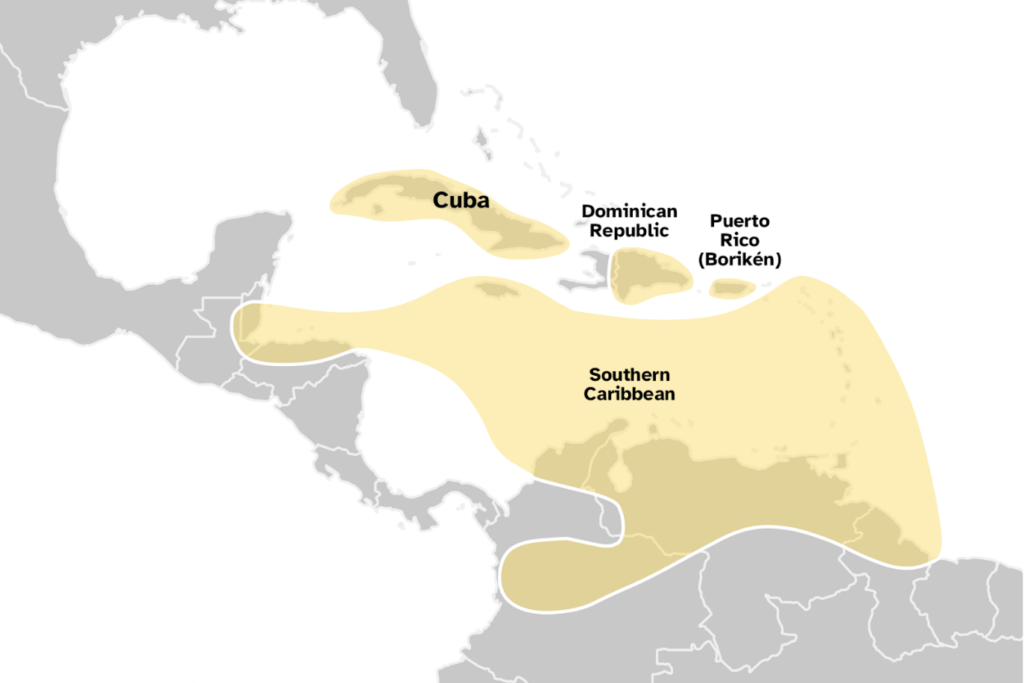23andMe has added finer detail for customers with roots that trace back to four Indigenous Caribbean populations, which include Indigenous ancestry in Puerto Rico, the Dominican Republic, Cuba, and the Southern Caribbean.
The update is part of our continuing work to improve 23andMe’s ancestry reports and features. This new update allows customers with ancestry from these regions to see connections back to populations indigenous to Puerto Rico, the Dominican Republic, Cuba, and other parts of the Caribbean and surrounding mainlands.
About two percent of 23andMe’s customers who have tested on our latest genotyping chip will receive a match to one or more of the groups.
Indigenous Populations in the Caribbean
It’s believed that humans first settled these islands more than 6,000 years ago. It’s also where Indigenous Americans first encountered European explorers and colonizers after 1490 to devastating effect.
The region’s indigenous populations collapsed within decades after Spanish expeditions first encountered the native Arawak people living in the Bahamas, Cuba, and Hispaniola. The dramatic decimation of these populations was due to disease, enslavement, and outright killing by these early colonizers.
But recent studies of ancient DNA show that traces of the early pre-colonial populations can still be found in people with roots in this region. People from these regions often have mixed ancestry, including contributions from their African, European, and Indigenous ancestors.
Ancestry Composition update
23andMe’s Ancestry Composition report is a living analysis that improves as we add new reference data. Underlying our ancestry reports are powerful algorithms and analytical tools developed by 23andMe population geneticists and engineers to offer our customers more insights into their ancestral origins.
Over the last few years, we’ve updated results for people with African Ancestry, Chinese ancestry, Indigenous American ancestry, British and Irish ancestry, as well as Latinx ancestry, for instance. Customers may already see evidence of recent ancestry from the Iberian Peninsula. Still, this update and these genetic groups represent improvements in accuracy. They also reflect the distinct regional populations and customers’ ancestry.
Regions in the Caribbean covered in this update
Around 80 percent of customers with four grandparents from Puerto Rico, Cuba, or the Dominican Republic will receive a match (and if those customers have more than five percent Indigenous American ancestry, around 95% will receive a match).

Many of these genetic groups likely reflect genetic ancestry related to the Taíno people who were Indigenous to the Greater Antilles, from Cuba in the West to Puerto Rico and the northernmost Leeward Islands of the Lesser Antilles in the East.
For the Southern Caribbean Genetic Group, there is also evidence of genetic ancestry related to the Garifuna people of the Windward islands of the Lesser Antilles. The Garifuna (Garínagu) people are descended from the Indigenous Kalinago inhabitants of Saint Vincent and the formerly enslaved West African people in the Lesser Antilles. Most Garifuna now live in eastern Central America, following the forced transportation of the Garifuna to the Bay of Honduras in the late 18th century.
More on Populations from these Regions
- Dominican Republic: Ayiti, the Taíno name for Hispaniola, was the cultural heartland of the Taíno civilization, which extended from Cuba in the west to the Lesser Antilles in the east and reached its zenith just before European contact.
- Puerto Rico: In the late 1400s, after Spanish colonizers reached Borikén (the Taíno name for Puerto Rico), the island’s Indigenous Taíno population was decimated. Most Puerto Ricans have between 5–15 percent Indigenous American ancestry. Today, more and more Puerto Ricans celebrate their Indigenous heritage, including through efforts to reconstruct the extinct Taíno language.
- Cuba: Humans have lived in Cuba for over six thousand years, but the Indigenous Taíno People were the predominant culture during European contact.
- Southern Caribbean: Many people in this genetic group speak Caribbean Creoles or Indigenous languages in the Cariban or Ta-Arawakan families, such as Garifuna. The Garifuna (Garínagu) people descended from the Indigenous Kalinago inhabitants of Saint Vincent and the formerly enslaved West African people in the Lesser Antilles. Most Garifuna now live in eastern Central America, following the forced transportation of the Garifuna to the Bay of Honduras in the late 18th century.
Find out more
23andMe customers who want to learn more about their Ancestry Composition can go here.
Not yet a customer? Find out more about 23andMe’s Ancestry Service and other services offered to customers here.




